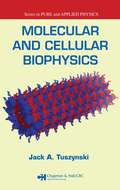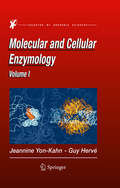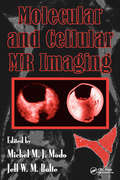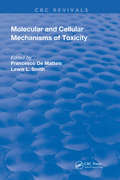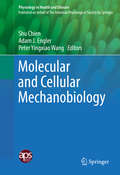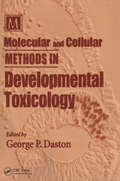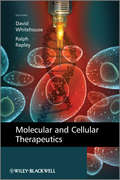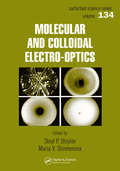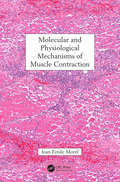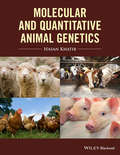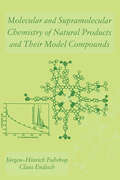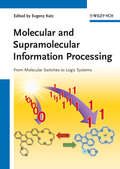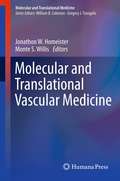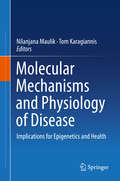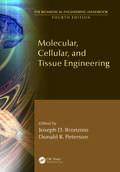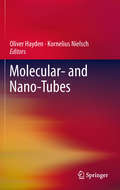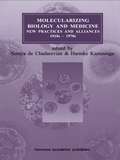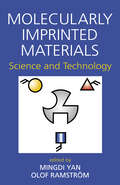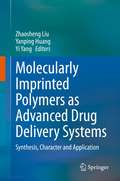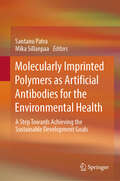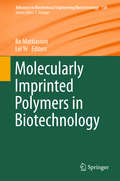- Table View
- List View
Molecular and Cellular Biophysics (Pure and Applied Physics)
by Jack A. TuszynskiFrom quantum theory to statistical mechanics, the methodologies of physics are often used to explain some of life's most complex biological problems. Exploring this challenging yet fascinating area of study, Molecular and Cellular Biophysics covers both molecular and cellular structures as well as the biophysical processes that occur in these structures. Designed for advanced undergraduate and beginning graduate students in biophysics courses, this textbook features a quantitative approach that avoids being too abstract in its presentation.Logically organized from small-scale (molecular) to large-scale (cellular) systems, the text first defines life, discussing the scientific controversies between mechanists and vitalists, the characteristics of living things, and the evolution of life. It then delves into molecular structures, including nucleic acids, DNA, RNA, interatomic interactions, and hydrogen bonds. After looking at these smaller systems, the author probes the larger cellular structures. He examines the cytoplasm, the cytoskeleton, chromosomes, mitochondria, motor proteins, and more. The book concludes with discussions on biophysical processes, including oxidative phosphorylation, diffusion, bioenergetics, conformational transitions in proteins, vesicle transport, subcellular structure formation, and cell division.
Molecular and Cellular Enzymology
by Jeannine Yon-Kahn G. HervéMolecular and Cellular Enzymology addresses not only experienced enzymologists but also students, teachers and academic and industrial researchers who are confronted with enzymological problems during their fundamental or applied research. In this field there is an urgent need for training in order to meet the requirements of both research and industrial endeavours. This book consists of several levels. Practical aspects and elementary explanations are given for the benefit of non-specialists' and students' understanding. In order to facilitate the task of students, two typographies have been adopted. The main text corresponds to basic knowledge, whereas text in a smaller font provides more specialised information. Specialists will also find topics more deeply expounded with the principal bibliographic references cited. The bibliography, however, is not exhaustive; the choice includes general books and review articles as well as some specialised articles. In this book, for the first time, the different molecular and cellular aspects of enzymology are presented together. Until now, there has been no book available in which these different aspects are treated in the same volume. In addition, besides the theoretical developments, this book provides a wealth of practical information for experimentalists.
Molecular and Cellular MR Imaging
by Jeff W. M. Bulte Michel M. J. ModoThe ability of molecular and cellular imaging to track the survival, migration, and differentiation of cells in vivo as well as monitor particular gene expression in living subjects is rapidly moving from the research laboratory into daily clinical settings. The interdisciplinary nature of the field mandates a constant dialogue among molecular and
Molecular and Cellular Mechanisms of Toxicity (Routledge Revivals)
by Lewis L. Smith Francesco De MatteisFirst Published in 1995: Written by specialists in their fields, this book contains short reviews intended to highlight points of growing interest in mechanistic toxicology. The first section considers selected aspects of molecular mechanisms, including selectivity of toxic agents and repair processes in the nervous system, toxicity of oxygen, fibers and aflatoxins. The second section discusses the interactions of carcinogens with DNA, and other targets, and their relevance to both molecular dosimetry of exposure and development of cancer. The final part is concerned with cellular and genetic aspects and includes coverage of some of the most recent and rapidly developing problems in toxicology.
Molecular and Cellular Mechanobiology
by Shu Chien Adam J. Engler Peter Yingxiao WangThis book will cover the cutting-edge developments in molecular and cellular mechanobiology to date. Readers will have a clear understanding of mechanobiology at the molecular and cellular levels, encompassing the mechanosensors, transducers, and transcription. An integrative approach across different scales from molecular sensing to mechanotransduction and gene modulation for physiological regulation of cellular functions will be explored, as well as applications to pathophysiological states in disease. A comprehensive understanding of the roles of physicochemical microenvironment and intracellular responses in determining cellular function in health and disease will also be discussed.
Molecular and Cellular Methods in Developmental Toxicology (Methods in Life Sciences - Toxicology Section)
by George P. DastonThis new manual provides a convenient source of experimental procedures, including the most modern and frequently used molecular and cellular techniques. Experimental protocols have been carefully selected by developmental toxicologists for developmental toxicologists. The most important new trends, such as evaluation of the safety of therapeutic antisense oligonucleotides, studies of the role of cell death in abnormal development, and the identification of sparingly expressed developmental control genes are featured. This is the perfect manual for scientists trained in classical developmental toxicology who want to add molecular and cellular methods to their research.
Molecular and Cellular Physiology of Neurons, Second Edition
by Gordon L. FainGordon Fain's Molecular and Cellular Physiology of Neurons, Second Edition is intended for anyone who seeks to understand nerve cell function: undergraduate and graduate students in neuroscience, students of bioengineering and cognitive science, and practicing neuroscientists who want to deepen their knowledge of recent discoveries.
Molecular and Cellular Therapeutics
by David Whitehouse Ralph RapleyMolecular and Cellular Therapeutics aims to bring together key developments in the areas of molecular diagnostics, therapeutics and drug discovery. The book covers topics including diagnostics, therapeutics, model systems, clinical trials and drug discovery. The developing approaches to molecular and cellular therapies, diagnostics and drug discovery are presented in the context of the pathologies they are devised to treat.
Molecular and Colloidal Electro-optics
by Stoyl P. Stoylov Maria V. StoimenovaMolecular and Colloidal Electro-Optics presents cohesive coverage from internationally recognized experts on new approaches and developments in both theoretical and experimental areas of electro-optic science. It comprises a well-integrated yet multi-disciplinary treatment of fundamental principles, strategies, and applications of electro-op
Molecular and Computational Modeling of Cardiac Function (Handbook of Modern Biophysics #7)
by Thomas JueIn Molecular and Computational Modeling of Cardiac Function, a group of prominent professors and researchers explain the fundamental concepts of molecular modeling and illustrate the biomedical applications. The book covers the following topics: Principles of atomistic modeling and simulation of biomolecular systems. Using atomistic modeling to predict the cardiotoxicity of an arrhythmia drug molecule. Bifurcation phenomena in cardiac system as control design of automaticity and arrhythmia. Modeling the role of myoglobin as a fatty acid transporter. Population-based computational approaches to investigate cardiac arrhythmia.
Molecular and Functional Models in Neuropsychiatry
by Jim J. HaganThe development of more effective treatments for neuropsychiatric disorders requires scientific progress on a broad front. Animal models have a vital role to play in advancing the field. When deployed in conjunction with detailed study of these diseases in man they bring the power to make controlled experimental interventions which allow the functional consequences of genetic variations and polymorphisms to be understood in terms of their cellular, systems and behavioural effects. Further, they provide a means by which complex cognitive and behavioural phenomena may be dissected and understood. Finally, they provide a bridge to understanding the effects of drugs on the functioning of the central nervous system, thereby improving our understanding of the actions of those drugs in man.
Molecular and Physiological Mechanisms of Muscle Contraction
by Jean Emile MorelThoroughly researched using experimentation and re-examination of all previously published evidence, Molecular and Physiological Mechanisms of Muscle Contraction is a carefully crafted treatise and revision of previous conceptions of muscle contraction. It presents detailed descriptions of new, previously unpublished data and hybrids recent finding
Molecular and Quantitative Animal Genetics
by Hasan KhatibAnimal genetics is a central topic in upper-level animal science programs. Filling a void in existing literature on animal science, Animal Genetics introduces genetic principles and presents their application in production and companion animals. The book details population and quantitative genetics, epigenetics, biotechnology, and breeding among other topics. Useful in upper-level studies, Animal Genetics is an irreplaceable educational resource.
Molecular and Supramolecular Chemistry of Natural Products and Their Model Compounds
by Jurgen-Hinrich Fuhrhop Claus EndischAn assessment of the known properties of natural products and their model compounds to determine their usefulness in biological and medical experimentation, as well as in synkinetics - the reversible synthesis of noncovalent compounds. It explores new techniques such as cryoelectron and scanning force microscopy and solid-state NMR spectroscopy of
Molecular and Supramolecular Information Processing
by Evgeny KatzEdited by a renowned and much cited chemist, this book covers the whole span of molecular computers that are based on non-biological systems. The contributions by all the major scientists in the field provide an excellent overview of the latest developments in this rapidly expanding area. A must-have for all researchers working on this very hot topic. Perfectly complements Biomolecular Information Processing, also by Prof. Katz, and available as a two-volume set.
Molecular and Therapeutic actions of Thymoquinone: Actions Of Thymoquinone
by Hina YounusThroughout history black seeds, Nigella sativa seeds, have been highly revered for its medicinal properties. Thymoquinone (TQ), an active principle component of the volatile oil of black cumin seeds, is an emerging natural compound with a wide range of medical applications, and has several beneficial pharmacological actions i.e anti-oxidant, anti-diabetic, anti-inflammatory, anti-microbial, anti-tumor, anti-mutagenic, anti-epileptic, hepatoprotective, neuroprotective, and nephroprotective. As such, it is important to move TQ from the bench to bedside. This book illustrates the therapeutic importance of TQ, offering a detailed account of some of its molecular and therapeutic properties, and discussing in depth its anti-diabetic, anti-cancer, anti-oxidant, anti-inflammatory, anti-microbial, anti-epileptic and hepatoprotective actions. Lastly, the book examines the future prospects of TQ research and its use as a pharmaceutical.
Molecular and Translational Vascular Medicine
by Monte S. Willis Jonathon W. HomeisterMolecular and Translational Vascular Medicine will serve as a state-of-the-art resource for physicians and translational medical researchers alike who are interested in the rapidly evolving field of vascular medicine. The text provides new insight into the basic mechanisms of classic vascular pathophysiologic processes like angiogenesis, atherosclerosis, thrombosis, and vasculitis. Furthermore, it covers new areas of investigation including the role of the ubiquitin proteasome system in vascular disease, endothelial progenitor cells for disease treatment, and the genetic basis of thoracic aortic aneurysms. Lastly, this volume includes sections on the newly emerging field of therapeutic angiogenesis, and the developing technology of nanoparticle-based imaging and therapeutic treatment of the diseased vasculature. All chapters are written by established experts in their fields, including pathologists, cardiovascular surgeons, and internists as well as translational biomedical researchers in a wide range of disciplines. While comprehensive, the material is presented in a manner that simplifies the complex pathophysiologic mechanisms that underlie common vascular diseases. Molecular and Translational Vascular Medicine will be of great value to a broad audience including internists, cardiovascular and vascular surgeons, pathologists, residents and fellows, as well as translational biomedical researchers.
Molecular mechanisms and physiology of disease
by Nilanjana Maulik Tom KaragiannisIn a simplified form, epigenetics refers to heritable changes in phenotype that are not due to changes in the underlying DNA sequence. In this book, epigenetic mechanisms of regulation and dysregulation in health and disease are explored in great depth. Detailed chapters on epigenetic processes including DNA methylation and chromatin post-translational modifications including potential interventions with DNA methyltransferase inhibitors and histone deacetylase inhibitors are explored in initial chapters. These provide a detailed overview and important background to the entire field. The book is then focussed on epigenetic mechanisms involved in various diseases including anti-inflammatory and autoimmune conditions. Important accounts relating to the effects of epigenetics in metabolic syndrome, cardiovascular disease and asthma are the focus of subsequent chapters. The role of epigenetic dysregulation in malignancy is a current topic of interest and represents an intense field of research. A large component of this book is dedicated to the analysis of aberrant epigenetic processes in carcinogenesis and cancer progression. Further, chapters are focused on emerging cancer prevention using nutritional components and anti-cancer therapies particularly with histone deacetylase inhibitors, which have already been approved for the treatment of cutaneous T-cell lymphoma. The emerging role of nanoparticle preparations, especially in the context of delivering potential epigenetic therapies to target cells in various diseases, is also explored in this book. Overall, this book encompasses a wide range of topics related to epigenetic mechanisms in health and disease and would appeal to anyone with an interest in epigenetics, chromatin biology and emerging epigenetic interventions and therapies.
Molecular, Cellular, and Tissue Engineering (The Biomedical Engineering Handbook, Fourth Edition)
by Joseph D. Bronzino Donald R. PetersonKnown as the bible of biomedical engineering, The Biomedical Engineering Handbook, Fourth Edition, sets the standard against which all other references of this nature are measured. As such, it has served as a major resource for both skilled professionals and novices to biomedical engineering.Molecular, Cellular, and Tissue Engineering, the fourth volume of the handbook, presents material from respected scientists with diverse backgrounds in molecular biology, transport phenomena, physiological modeling, tissue engineering, stem cells, drug delivery systems, artificial organs, and personalized medicine.More than three dozen specific topics are examined, including DNA vaccines, biomimetic systems, cardiovascular dynamics, biomaterial scaffolds, cell mechanobiology, synthetic biomaterials, pluripotent stem cells, hematopoietic stem cells, mesenchymal stem cells, nanobiomaterials for tissue engineering, biomedical imaging of engineered tissues, gene therapy, noninvasive targeted protein and peptide drug delivery, cardiac valve prostheses, blood substitutes, artificial skin, molecular diagnostics in personalized medicine, and bioethics.
Molecular- and Nano-Tubes
by Oliver Hayden Kornelius NielschMolecular- and Nano-Tubes summarizes recent advancements in the synthesis, fabrication and applications of tubular structures. An interdisciplinary overview of innovative science focused on tubular structures is provided. The reader is offered an overview of the different fields that molecular and nano tubes appear in, in order to learn the fundamental basics as well as the applications of these materials. This book also: Shows how nanotechnology creates novel materials by crossing the barriers between biology and material science, electronics and optics, medicine and moreDemonstrates that tubes are a fundamental element in nature and used in disparate applications such as ion channels and carbon nanotubes Molecular- and Nano-Tubes is an ideal volume for researchers and engineers working in materials science and nanotechnology.
Molecularizing Biology and Medicine: New Practices and Alliances, 1920s to 1970s (Routledge Studies in the History of Science, Technology and Medicine)
by Harmke Kamminga Soraya de ChadarevianThe contributors present a coherent set of case studies of practices, technologies and strategies aimed at the isolation, investigation, manipulation, production, and uses of molecules including vitamins, hormones, blood products, antibiotics, and vaccines. These case studies examine how processes of molecularization were set in motion in the inter-war period, how they were used as a resource in the biomedical 'mobilization' of World War II, and how new alliances and strategies created as part of the war effort played a central role in the reorganisation of biomedicine in the post-war period.
Molecularly Imprinted Materials: Science and Technology
by Mingdi Yan Olof RamströmWritten by pioneering experts in the field, this book offers a wide range of approaches for molecular imprinting, experimental protocols that exemplify specific techniques, and a detailed survey on molecular imprinting research and applications. It supplies a comprehensive tutorial for learning basic techniques and making new contributions to the field, as well as in-depth discussions, guidelines, and experimental protocols to help beginners gain a jump-start in the field of molecular imprinting. Molecularly Imprinted Materials: Science and Technology contains a multitude of experimental protocols illustrating specific techniques discussed in the text.
Molecularly Imprinted Polymers as Advanced Drug Delivery Systems: Synthesis, Character and Application
by Yi Yang Zhaosheng Liu Yanping HuangThis book summarizes the recent advancements for drug delivery systems (DDS) in terms of fundamental principles, rapidly emerging techniques and developing frontiers of molecular imprinting. Especially with the combination of enantioselective molecularly imprinted polymers and water compatible molecularly imprinted polymers, stimuli responsive imprinted DDS have been innovated and applied to dermal delivery, ophthalmic drugs and cancer treatment. This philosophy comprehensively revolutionizes the treatment strategy of human healthcare and provides the possibility to re-trigger in vivo an exhaust system after the complete release of the starting drug cargo, thus enabling precision medicine. To this end, the following unique features will be discussed and concluded: 1) State-of-the-art definition of MIP as drug delivery systems. 2) Advanced techniques and clinical applications of MIP as drug delivery systems in the past decade. 3) Novel frontiers and brand-new technologies, for example, drug delivery devices for zero-order sustained release and stimuli responsive imprinted DDS. 4) Revolutionary impact on dermal delivery, ophthalmic drugs and cancer treatment. 5) Future challenges and perspectives
Molecularly Imprinted Polymers as Artificial Antibodies for the Environmental Health: A Step Towards Achieving the Sustainable Development Goals
by Santanu Patra Mika SillanpaaThis book covers the fundamental principles of molecularly imprinted polymers (MIPs) and their synthesis methodologies, offering readers a solid understanding of these unique materials. It delves into the design and selection of template molecules for imprinting, as well as polymerization techniques and strategies for optimizing MIP performance. With a focus on real-world applications, the book showcases the wide range of environmental health problems that MIPs can address. It discusses the detection and quantification of pollutants in air, water, and soil using MIP-based sensors and biosensors. Additionally, it explores the use of MIPs in environmental remediation, such as the adsorption and removal of contaminants, as well as the development of MIP-based materials for water and soil treatment. The book also highlights the analytical applications of MIPs in environmental health, including separation and purification techniques, sample preparation, and preconcentration methods. It examines how MIPs can be integrated into analytical instrumentation and detection systems to enhance environmental analysis. By bringing together interdisciplinary knowledge from the fields of environmental science, chemistry, polymer science, analytical chemistry, and environmental engineering, this book provides readers with a comprehensive understanding of the potential of MIPs as artificial antibodies for environmental health. With its emphasis on real-world applications and case studies, it offers practical insights that researchers, academics, and professionals can apply in environmental monitoring, remediation, and analysis projects.
Molecularly Imprinted Polymers in Biotechnology
by Bo Mattiasson Lei YeControlled radical polymerization techniques for molecular imprinting, by Mark E. Byrne From bulk polymers to nanoparticles, by Lei Ye Post-imprinting and in-cavity functionalization, by Toshifumi Takeuchi Characterization of MIPs (affinity, selectivity, site heterogeneity. . . ), by Richard Ansell Theoretical aspects and computer modelling, by Ian Nicholls MIPs in aqueous environments, by Bin Lu MIPs for binding macromolecules, by Kenneth J. Shea Solid phase extraction, by Ecevit Yilmaz Sensors, by Sergey A. Piletsky MIPs for catalysis and synthesis, by Marina Resmini Wastewater treatment, by Bo Mattiasson MIPs as tools for bioassays, biotransformation and drug delivery, by Meiping Zhao
